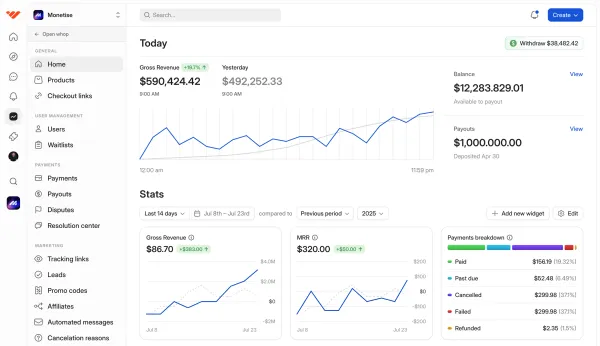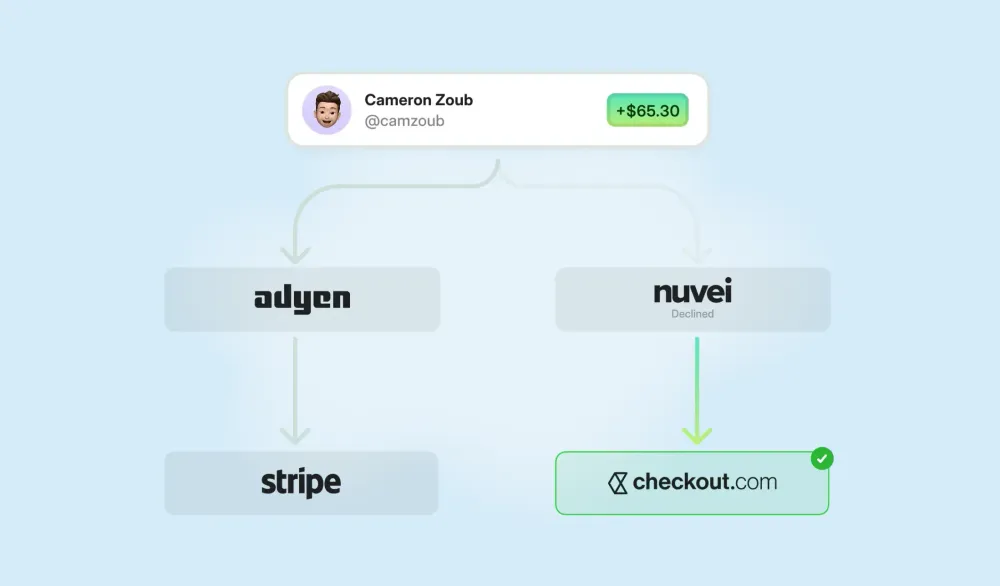When I first started freelancing I earned $23k a year - now I earn $250k. Read this guide to discover how I started and grew my freelance business.
Key takeaways
- US freelancers earn an average salary of over $99,000 annually.
- The number of full-time freelancers grew by 90% between 2020 and 2023.
- Specializing in a profitable niche helps freelancers avoid competing on price.
- Building an online presence through websites and social media attracts quality clients.
- Automation tools like Zapier and Dubsado help freelancers scale their businesses efficiently.
Freelancing is a great career choice for those who want to set their own schedules, choose who they work with, and play by their own rules.
I've been in the trenches for years, and let me tell you, it's a wild ride. From scraping by on $23k to hitting that sweet $250k spot, I've seen the highs, lows, and everything in between.
But here's what gets me excited: freelancing is whatever you make it. There's no ceiling, no boss breathing down your neck, and definitely no one-size-fits-all playbook. Whether you're dreaming of escaping the 9-5 grind or ready to build an empire from your living room, freelancing might just be the answer.
In this guide, I'm spilling all the tea—from finding your first clients to scaling up without burning out. No fluff, no sugar-coating, just real talk about what it takes to make it as a freelancer in 2024.
How much money do freelancers make?
The great thing about freelancing is there’s no glass ceiling. I’ve made everything from $23,000 a year to $250,000 a year freelancing, and I know plenty of other freelancers who have had a similar experience.
According to Upwork, freelancers in the US earn an average salary of over $99,000 a year—the range spans from $31,000 to $275,000.
In a Reddit thread, freelancers from a diverse range of industries admit to earning anywhere from $1,000 to $3,000 a week freelancing, depending on how much work they have on and whether they’re in a slow or busy season of business.
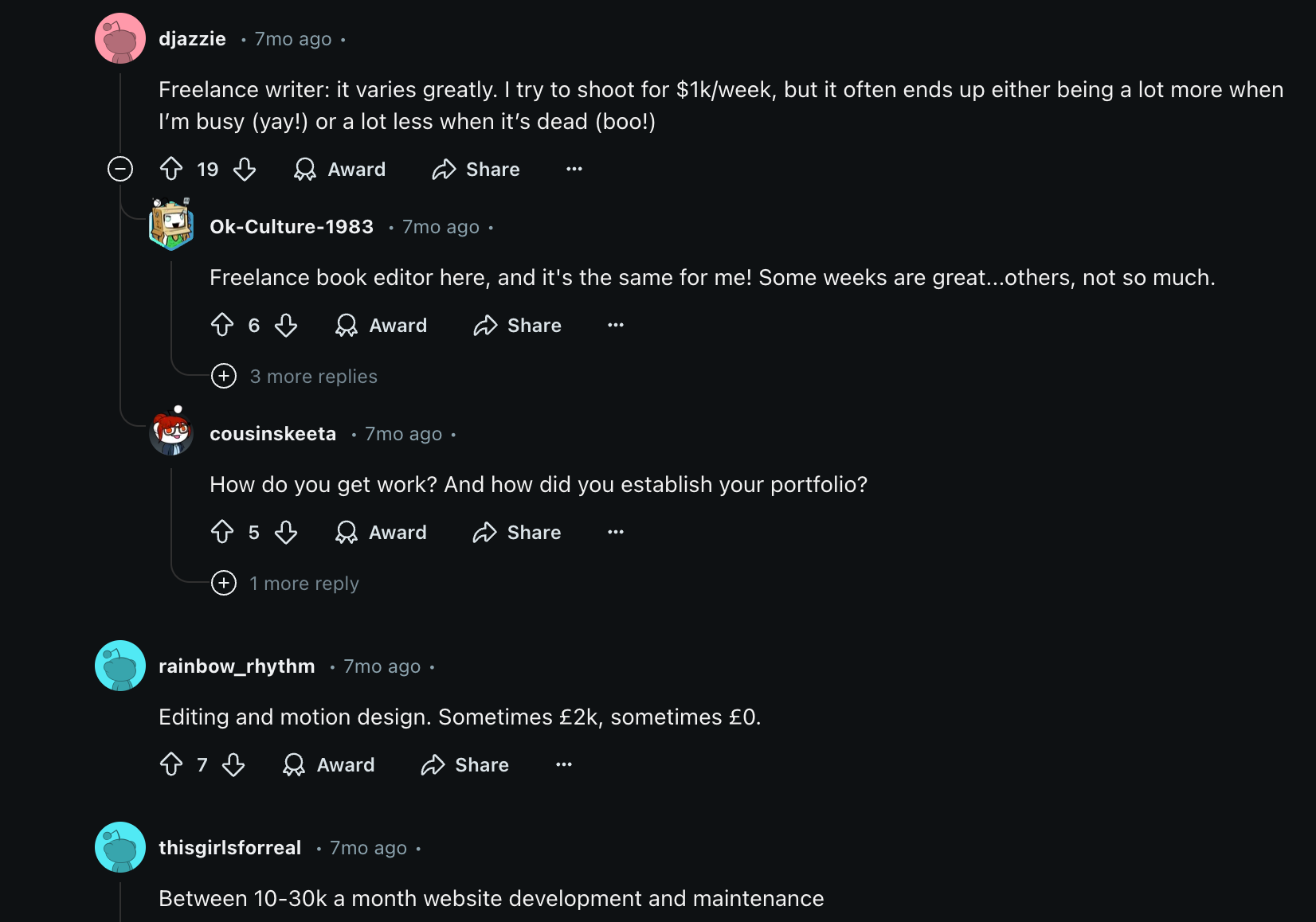
Launching your freelance career in 5 steps
Ready to kick things off? Here’s my step-by-step guide to getting started.
1. Define clear goals for your freelance career
I’ll be honest, I was 100% winging it at the start of my freelance career. 23-year-old me had no real plan and no idea what lay ahead, so it was nearly impossible to set goals.
That being said, I highly recommend at least thinking about what you’d like to achieve through freelancing—especially if you want to build a profitable business.
This step is all about figuring out what you want to do, honing in on who you want to serve, and how you’ll stand out (because, yes, the competition is wild right now—the number of full-time freelancers in the US grew by 90% between 2020 and 2023).
Identify a profitable niche
Freelancing is a huge market and a broad approach can often leave you feeling like a tiny fish in a gigantic pond.
This is why it helps to find a niche. If you become the go-to person in your niche for your specific skill set, you have a much better chance of building a profitable, long-lasting business.
Start by thinking about specific problems that clients urgently need help with—and are willing to pay for. Consider your skills and ask yourself what you excel at and where you add unique value. Then, research your field and listen to client feedback to find a sweet spot that’s not oversaturated.
For example, I originally started out as a travel and lifestyle writer.
The competition was hot and it meant I often struggled to stand out (and get paid well). Over time, I switched things up and honed in on ecommerce technology. At the time, I was one of the first freelancers to specialize in this industry, so it was incredibly fruitful.
I’ve been able to build a reputation in this area, which means I no longer have to compete in a race to the bottom with other freelancers.
Understand your target clients
After identifying your niche, it’s time to understand your target clients.
Who are they, and what are their biggest pain points? What are they willing to invest in?
Think about who your ideal clients are in terms of industry, company size, and their primary goals.
Deeply understanding them will help you tailor your messaging and positioning to fit their needs and show that you "get" their challenges. This ultimately makes you a more attractive choice compared to competitors.
2. Build a high-quality portfolio
Your portfolio is your golden ticket to landing clients, especially in the early days when your reputation is still growing.
A good portfolio doesn’t need to be massive but it should showcase your best work and provide a snapshot of your skills, style, and results.
If you’re just starting out, consider taking on a few small projects at a discount or creating samples based on real client needs in your chosen niche.
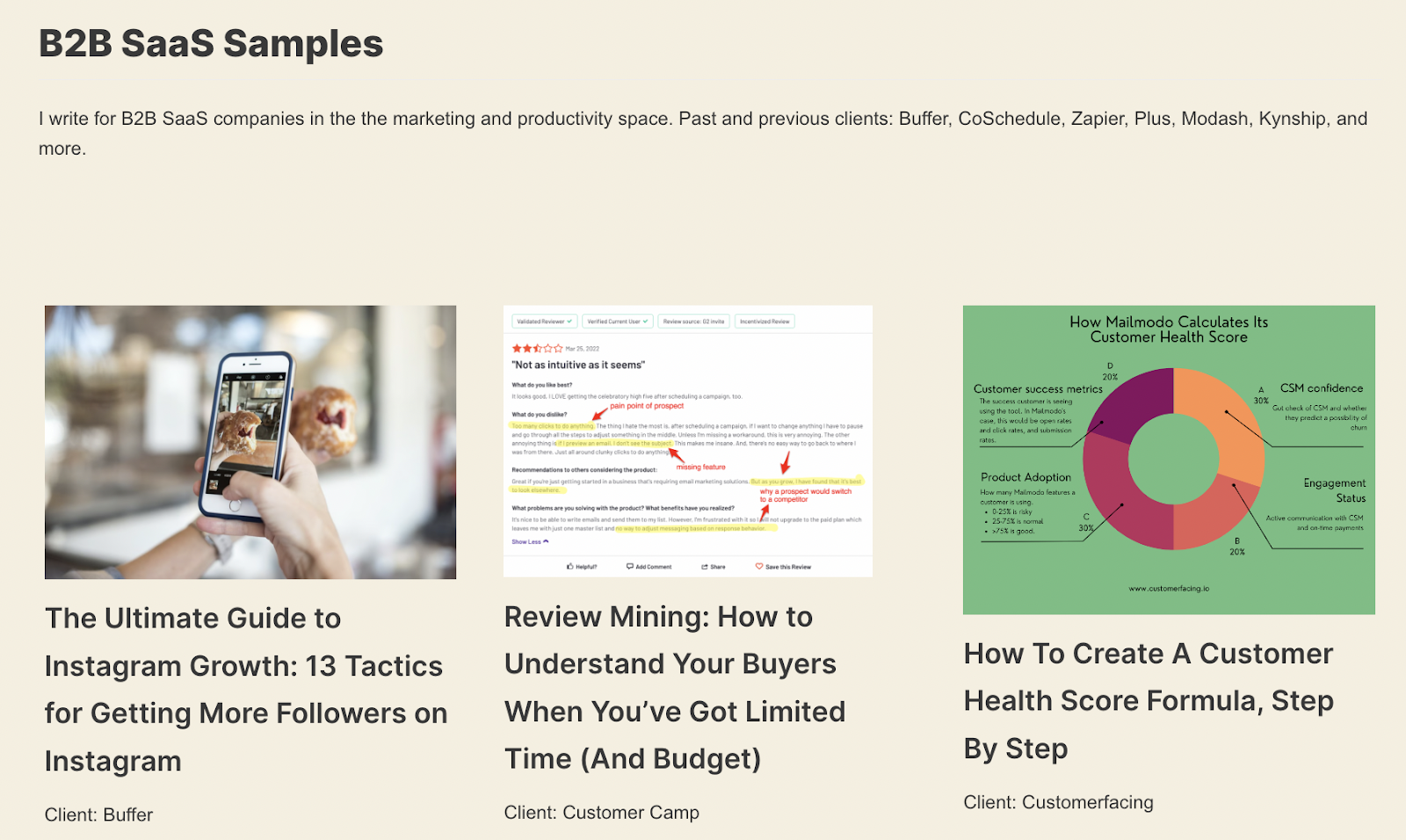
Use metrics to showcase results wherever possible (like "increased engagement by 50%" or "led to 20% more sign-ups") and structure each example with a clear overview of the problem, your approach, and the outcome.
3. Create an online presence
When I say building an online presence was the best thing I ever did for my business, I mean it. My website and social media handles are my digital storefronts where future clients can learn about my expertise, style, and personality, all in one place.

The best social media platforms for freelancers
While it’s tempting to be everywhere online, focusing on just a few strategic platforms will save time and make your outreach more effective.
LinkedIn is a fantastic platform for freelancers in B2B sectors or those targeting professional clients—it’s designed for networking and showcasing your skills.
For visually creative freelancers, Instagram is a goldmine, while X or Threads are perfect for sharing industry insights and engaging in relevant conversations.
Don’t underestimate the power of having a personal website or blog, either. It doesn’t need to be fancy, but it should be clear, easy to navigate, and direct clients to how they can work with you.
4. Develop a competitive pricing strategy
Pricing is the bane of every freelancer’s life—are you charging too much? Too little? I’ve been through the wringer over the years trying to find the perfect price point, but it’s often a game of trial and error.
Despite this, you can give yourself a helping hand by researching what others in your field are charging (keep in mind that the cheapest rates won’t attract high-quality clients).
Look at other successful freelancer websites or scour platforms like Upwork to get a general feel for the prices in your niche.
The pricing strategy you settle on will depend on your skills, clients, and the type of work you offer. Here are some of the most common strategies:
- Hourly rates. This is where you charge for how many hours you’ve worked. It can be a good tactic while you figure out how long it takes you to do certain tasks, but you can end up punishing yourself the better and quicker you get.
- Project rates. This is where you charge “per piece” or “per project”. For example, you might have a set fee to design a website or a set fee for writing a white paper.
- Per-word rates. This is mostly reserved for writers and refers to charging per word. It can be useful for figuring out the price of lengthy projects, but it doesn’t always take into account the thinking, planning, and outlining time.
- Package rates. This is where you bundle together services into a package and charge a fixed rate. The beauty of this strategy is clients can mix and max packages or choose the right tier for their budget.
5. Market your freelance services effectively
If you want to attract new clients and demand higher rates, you have to put yourself out there—it’s not enough to create a website and hope for the best (trust me, I’ve tried it).
Marketing doesn’t have to be overwhelming. Instead, I recommend focusing on a few consistent, high-impact activities to get your name out there.
Leverage social media for exposure
I was skeptical about social media at first. Instagram was in its infancy when I started out and TikTok didn’t even exist, but I spent time promoting myself and my services on X (then Twitter).
Later, I moved to LinkedIn as well, which has been an excellent place to network with prospective clients.

For the best success on social media, create a plan for regularly posting content that shows off your expertise, engages your audience, and shares the results of your work. LinkedIn and Instagram Stories are great for sharing client wins and behind-the-scenes looks at your business, while X is perfect for quick insights or thoughts on industry trends.
You don’t need to sell directly in every post. Instead, focus on providing value and make it easy for potential clients to reach out when they’re ready.
Network with other freelancers and professionals
Connect with other freelancers, even those in similar niches, as they can refer clients to you if they’re booked up or need a skillset you offer.
Join online communities, attend industry events, and participate in webinars.
Some of my favorite communities are:
Building genuine relationships helps you gain referrals and, over time, establishes a strong support network to turn to when you need advice or collaboration opportunities.
Growing your business as a freelancer
Once you’ve got the basics down—your niche, portfolio, and online presence—it’s time to start scaling.
Growth in freelancing doesn’t have to mean taking on tons more clients; it can also mean refining your processes, charging higher rates, or positioning yourself as a trusted expert.
Start by evaluating where you want to be in a year and reverse-engineering the steps to get there, whether that’s upskilling, niching down even further, or exploring passive income streams like digital products or online courses.
Build and maintain strong client relationships
Think of each client interaction as an opportunity to build loyalty, not just close a project.
Consistent communication, transparency, and a focus on delivering results that matter to your clients will help build trust. Take time to understand your clients’ goals—not just on a project level, but their big-picture objectives.
If you’re a writer, for example, don’t just submit drafts. Frame your content in terms of how it helps their business grow or engage customers.
Here are some ways I build and maintain client relationships:
- Go all in with onboarding. I have a super-slick onboarding process that helps me understand each client’s needs and make sure we’re both on the same page.
- Check in. I’m big on communication. I’ll check in with clients at each stage of the project at a minimum (everyone likes to be kept in the loop).
- Go above and beyond. I’m not saying you need to do extra work for free. But I’ll always try and do my longstanding clients a favor if they ask. A good deed can go a long way.
- Ask for feedback. I always encourage my clients to share feedback at each stage of a project. I want to know more about their experience and see if there are any ways I can improve our working relationship.
Manage your time efficiently
If there’s one thing I wish I knew when I started my freelancing business, it’s that time management is everything. We’re solely in charge of making sure we meet deadlines and give ourselves enough time and space to complete projects to a high standard.
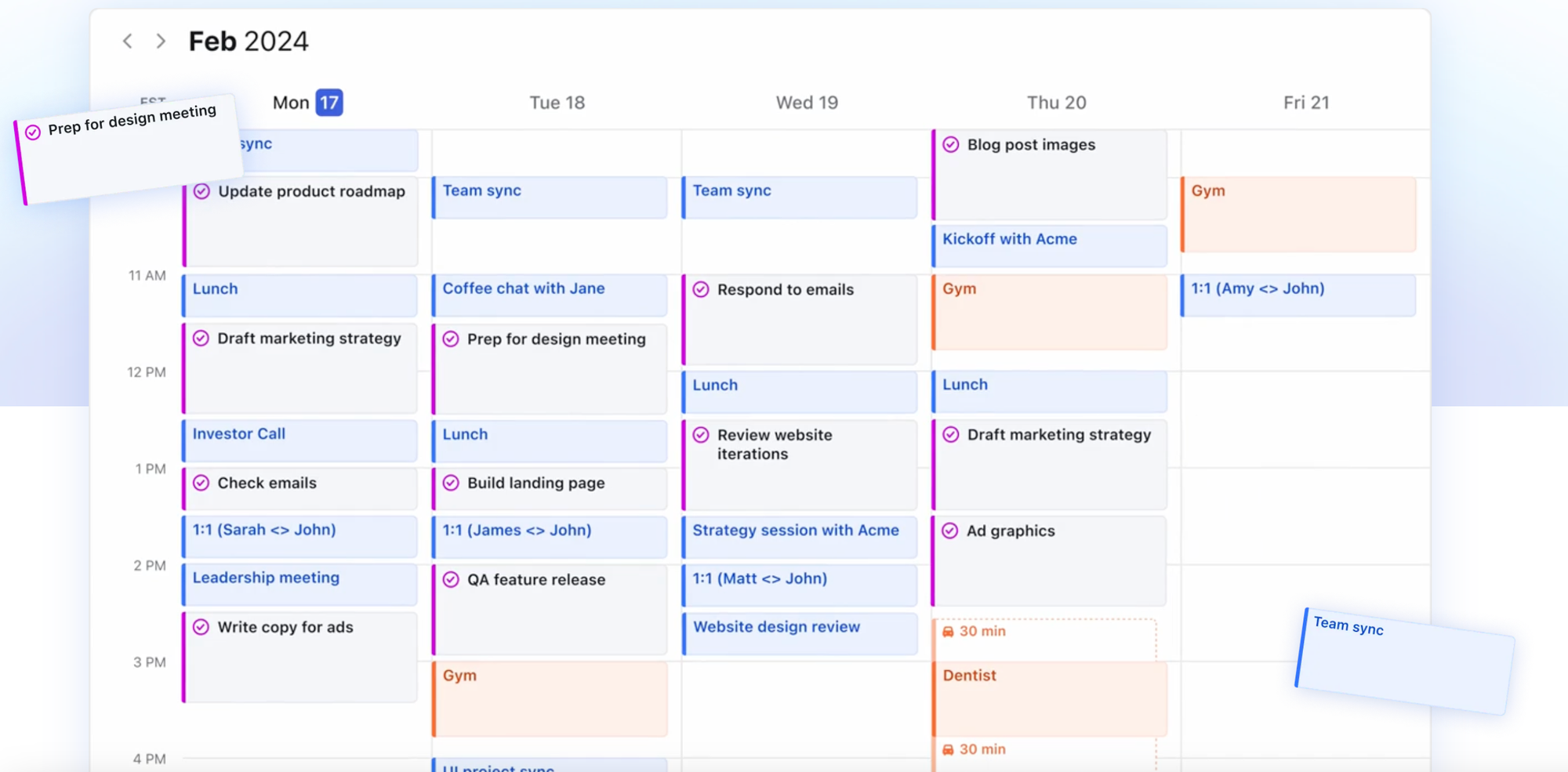
Without an efficient system, it’s easy to end up overwhelmed and burned out, especially as you start to take on more work. A solid time-management approach isn’t about cramming more into your day but structuring your time so you’re working smarter, not harder.
Automate processes for scalability
Automation is an absolute must, especially as your workload increases.
Consider automating tasks like invoicing, client onboarding, and follow-up emails. Tools like Zapier, Dubsado, or Asana can connect your apps, letting you trigger reminders, schedule social posts, or track project updates without needing to do it all manually.
Tip: write out every step you take when completing a project—I’m talking everything from the initial contact and discovery call right through to the final invoice and sign-off.
When you’ve got a list of steps, consider how you can speed up some of the steps with automation.
For example, my accounting platform automatically sends overdue invoice reminders, but you can also set up project management tools to send out regular updates to clients when a project moves to the next phase.
Set up a proper workspace
A dedicated workspace can completely shift your mindset from “just getting things done” to actually running a business.
Your workspace doesn’t have to be fancy, but it should be a place where you can focus, stay organized, and feel motivated.
Invest in a comfortable chair, good lighting, and any tech upgrades that help you work effectively. A clutter-free, ergonomic setup will make a world of difference in productivity and focus, helping you work with less stress and more clarity.
If, like me, you struggle to work from home for long stretches of time, consider joining a local coworking space or going halves on an office with a few other freelancers. Getting out of the house replenishes my creative juices and introduces me to more potential clients.
Build a business plan
Creating a business plan may sound formal, but it’s one of the most effective ways to map out where you’re heading.
This doesn’t need to be a corporate-style document—just a practical guide that outlines your goals, your ideal clients, your income targets, and how you’ll grow your freelancing business over time.
You might break down monthly revenue goals, outline what marketing strategies you’ll use, and track which services or packages bring in the most work. Checking in with this plan every quarter or so can help you stay focused, make informed decisions, and continually improve.
Check out the highest paying freelance jobs right here.
Stay updated with industry trends
As an independent contractor, clients will often look to you for insights, so make it a habit to follow industry leaders, read relevant blogs, and participate in webinars or online communities.
Look at what’s trending in your niche—whether it’s new tools, evolving client expectations, or changes in platform algorithms. Staying informed helps you adapt your services and approach, making you more valuable to your current clients and strengthening your position as an expert in your field.
The boring bits of freelancing
Let’s be real here: freelancing isn’t all creative work and flexible hours.
There’s also the nitty-gritty side—contracts, payments, taxes—that every freelancer needs to manage.
These “boring bits” might not seem exciting, but they’re crucial for keeping your business running smoothly. When you handle these tasks with the same professionalism and care as your core work, you’ll be in a much better position to grow and protect your business.
Developing contracts and agreements
It’s tempting to skip the paperwork when you’re first starting out (ask me how I know), but a clear, well-thought-out contract sets the foundation for a healthy client relationship and protects you if anything goes wrong.
Your contract should include key details like project scope, timelines, payment terms, and what happens if there are delays or extra requests.
It doesn’t have to be full of legal jargon, but it should cover the essentials and be crystal clear for both parties. And don’t forget about the terms for revisions—these can prevent potential disagreements down the line.
Here are a few key elements to include in your contract:
- Project scope and deliverables. Define exactly what you’re delivering. Instead of just saying, “social media strategy,” specify the number of posts, platforms, and any revisions included.
- Timeline and deadlines. Lay out project milestones, deadlines, and any consequences for delays (on both ends!). If the client has to deliver certain assets before you can do your bit, make it clear how delays on their side will affect the overall timeline.
- Payment terms. State when and how you expect to be paid, whether that’s upfront, upon completion, or split across milestones.
- Revision policy. Include the number of revisions you’ll provide, if any, within the quoted price.
Tip: as you gain more experience, you may want to create a contract template you can adjust for different projects.
Handling invoicing and payments
Consider using tools like FreshBooks, QuickBooks, or PayPal to automate invoicing and set up reminders, so you don’t have to chase clients for payment.

To make things easier for clients (and get paid faster), specify the payment terms in your contract and stick to them. Typical terms range from 7 to 30 days but choose a timeframe that aligns with your cash flow needs.
Always invoice promptly and send friendly follow-ups if payment is overdue. A quick message saying, “Just checking in on the status of the invoice sent on [date],” can work wonders.
Tip: if you often work with international clients, look into currency exchange and transfer fees so you’re not losing money in the process.
Understanding tax obligations
If I had a dollar for every freelancer I knew who got caught out because they hadn’t set aside enough for tax each year, I’d have a fair few dollars.
If you’re just starting out, I’d highly recommend investing in a consultation with an accountant who can help you understand the tax laws specific to your state or city, as well as what expenses you can claim.
Things like equipment, software, and even a portion of your rent or utilities (if you work from home) may be deductible.
It’s also a good idea to set up a separate bank account for taxes and transfer a set percentage of each payment into it.
This will make it easier when tax season rolls around and help you avoid any nasty surprises. Some freelancers also set up quarterly tax payments to stay on track and avoid a big bill at the end of the year.
Manage your freelance business to maintain a work-life balance
Without the structure of a traditional job, it’s easy to let work bleed into every part of your day, leading to burnout over time.
Establishing clear working hours, taking regular breaks, and setting boundaries with clients can make a huge difference. Make it a priority to carve out personal time, too—whether that’s through a hobby, regular exercise, or simply turning off notifications after hours.
Here are some of the ways I maintain a healthy work-life balance:
- I rarely work later than 5pm.
- I don’t work on weekends (and my clients know this).
- I take at least an hour for lunch every day.
- I only take client calls on certain days of the week.
- I schedule hobbies and me-time into my calendar as if it were client work.
Is freelancing worth it?
My honest answer is 100% yes, it’s worth it.
Freelancing can be incredibly rewarding, but it’s not without its challenges.
If you’re looking for flexibility, control over your work, and the chance to work on projects you genuinely enjoy, freelancing absolutely has its perks.
You get to choose your clients, set your rates, and build a business that fits your life instead of molding your life around work.
That said, freelancing isn’t a quick path to easy money or a stress-free lifestyle.
You’ll need to manage everything—from client relationships to invoicing, and the uncertainty that comes with not having a guaranteed paycheck. But if you’re prepared to put in the work, adapt to changes, and keep learning, freelancing can be an incredibly fulfilling career that offers freedom and autonomy like no other.
How Whop can help you launch and grow your freelance business
Juggling all the moving parts of a successful freelance business isn’t easy, but Whop’s flexible platform lets you sell products, services, and memberships all in one place.
It’s particularly great for freelancers who want to diversify their income by selling digital products or setting up subscriptions for clients who need ongoing support.
You can set up your whop to suit your business needs, making it simple to offer different tiers of services or product bundles that cater to various clients. Let's say you're a freelance writer - you can create your own writing community, sell one-one-one consulting calls, digital downloads (like templates and ebooks) and online courses, all from one whop.
For example, if you want to sell a bundle of templates or offer a premium membership for ongoing consulting, you can offer both these options in one place (your whop) and set different payment options for each - once-off for the templates, and recurring payments for consulting. Plus, Whop’s built-in analytics give you insights into which products are performing well, helping you refine your offerings and focus on what clients love most.
Ready to start a profitable freelance business? Create your Whop and start selling.



